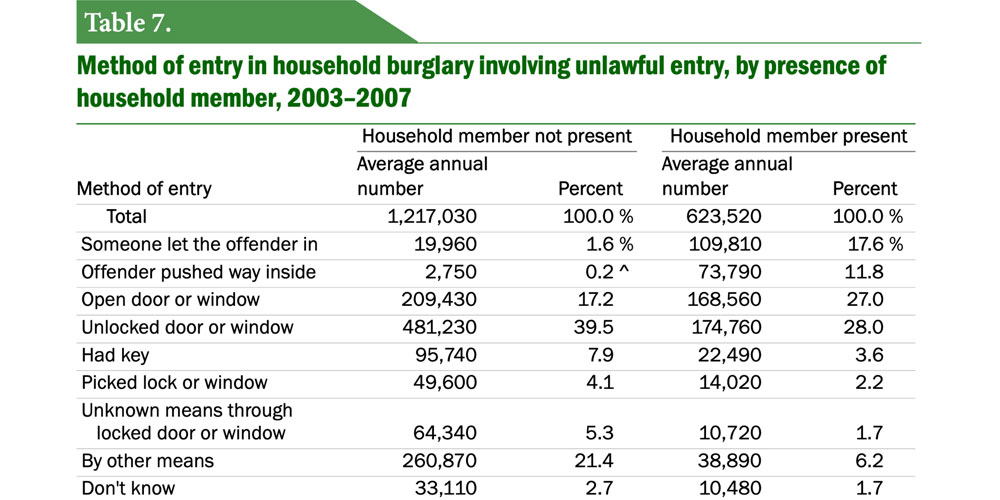Lock Blog
A resource for consumers, locksmiths, and security professionals
A resource for consumers, locksmiths, and security professionals

Whether or not criminals and burglars actually pick locks has been a topic of much debate in locksport and lock picking communities, and it is a question on the mind of anyone buying locks. Unfortunately, the answer you get is often something shallow like, “No one is going to pick a lock when they can break a window.” But is that statement true?
You have dedicated lock picking hobbyists doing their best to convince people no criminals pick locks because they do not want to be seen as contributing to any type of criminal enterprise. In other cases, people try to convince you to buy an unpickable lock because that is what they are selling.
As someone who understands the value of ethical recreational lock pickers and professional criminologists who investigate covert entry, I knew the answer wasn’t going to be a simple “yes or no” answer. It became clear this was going to need an article.
To get to the answer as to whether criminals pick locks we’ll be discussing the following:
Whether or not criminals pick locks has become a contentious topic in many online lock picking forums. This is understandable because most lock picking discussions are being had by morally upstanding individuals who are mechanically minded and interested in learning lock picking. After all, picking locks does make you feel like a secret agent/noir detective/Batman/god of doors.
But criminals picking locks does not impune the hobby of lock picking or the desire to educate people on how locks work. Thieves learned how to manipulate locks long before there was any popular discussion about lock picking. So whether or not criminals pick locks has nothing to do with lock picking hobbyists.
If anything, the lock picking hobbyists are our best defense against criminal lock pickers. It is only by finding weaknesses in our security that we can make the necessary improvements. For the same reason we need whitehat hackers constantly testing cybersecurity, we need ethical lock pickers finding the flaws before the criminals do.
Key Takeaways:
When you look at the history of locks and security innovators, it is clear that lock picking was a particularly large concern during the late 1700s and early 1800s. The great Alfred Charles Hobbs discussed the knowledge of “rogues” in his seminal book, Locks and Safes: The construction of locks, stating that rogues were able to acquire knowledge about lock picking without the aid of the still-developing locksmith community.
Hobbs wrote about how locksmiths may know about certain mechanical vulnerabilities in popular security devices but, “the dishonest are tolerably certain to be the first to apply the knowledge practically” (3). It was for that reason that he felt morally secure in his decision to “give fair play to those who might suffer in ignorance” (3) by informing the public on how locks worked and what could be done to make them work better.
The historical records are clear on the fact that criminals know about security weaknesses and their exploits without such knowledge being publicly available. And that all the public availability of this information does is help the masses understand risks and preventative measures. This is the historical precedent for the Lock Blog itself.
It was only when morally upstanding individuals began discussing criminal methods that security began to improve. The more public the shame for security vulnerabilities, the more meaningful the improvements were. A.C. Hobbs made it his life’s mission to publicly defeat the best locks of his era and prove that all locks can be picked so that innovations would continue before criminals found exploits.
Key Takeaways:

Probably the most notorious case of burglary involving lock picking is the Watergate scandal. The oversimplification of this historical event is that a group of men broke into the Watergate hotel to steal information and set up surveillance equipment in the offices of the Democratic national committee. And to do that, they had to covertly enter the office by picking the lock.
Virgilio R. Gonzales was chosen to handle the lock picking due to his background as a locksmith. As the story goes, upon his initial arrival at the hotel, it was discovered that he did not have the right tools with him, and they had to leave and come back. This story demonstrates both the need for advanced planning and specific knowledge to pick a lock.
The group was only detected because they had used tape on one of the locks to keep a door from closing. The lock picking itself was not discovered until the full investigation began. Meaning no suspicions were raised by the lock picking itself. The actual moments of burglary went undetected. Proving that criminals can pick locks in surveilled areas without being noticed.
The biggest diamond heist in history is also worth mentioning for its lock picking. Though the specifics are less documented, the mastermind behind the crime, Leonardo Notarbartolo, was an avid lock picker. He had also assembled a team with backgrounds in safe cracking, alarm exploits, and locksmithing to break into a vault covertly.
The group would never have been caught had they not made errors that undermined the perplexingly sophisticated crime where a vault was robbed with no clear indication as to how it was opened. That is the main reason criminals pick locks. To not be detected. This matters even more when the building’s security precautions rely on responding to detected threats.
Key Takeaways:

Many members of the locksport community like to stress the fact that criminals don’t pick locks. But even after the wonderful website, Art of Lock Picking, laid out their interpretation of the Department of Justice statistics on burglaries, they go on to say, “Note that I’m not using these numbers to say that malicious lock picking isn’t a problem.”
Let’s just set the record straight, there are criminals who pick locks, but the average criminal does not pick locks. Illegal lock picking does happen but it is less common than other forms of forced entry. To address the number that the quote from above was referring to, we can look at the screenshot from figure 7 of the Bureau of Justice Special Report.
One interpretation of the data is that 4% of only around 34% of burglaries makes lock picking quite uncommon, assuming that less than 2% of burglaries all involve actual lock picking and not just shimming. And when you consider the additional 2% of lock picking incidents that happen while people are home, the percentage of locking burglaries dips a little lower.
But there is more to consider. Quite a bit of the data falls into the categories where the entry method is unknown (6.4%). Maybe all the unknown entries were just more unlocked doors and loose keys, but lock picking is covert, and almost no one hires a forensic locksmith to investigate a burglary. And even with all that, the percentage does not increase too dramatically.
What if we stop looking at the numbers and start looking at the table descriptions and even the title of the document, “Victimization During Household Burglary.” The word “household” is extremely important, as we will see in the trend of recently reported crimes involving lock picks. The issue being that mainly commercial properties are targeted by lock picking criminals, not personal residences.
Think about how many people come back to a burglarized home and assume because a door is unlocked that they left it that way. It gets reported as an unlocked/open door or window, and no one suspects lock picking. How many of the over 56% of burglaries unlawful entry is uninvestigated instances of lock picking? We can’t know, but if you torture the numbers long enough, they will tell you anything you want to hear.
The problem with the data is that it is raw and unshaped. You can build whatever narrative around the numbers, provided you do a little bit of math along the way. But property crime data is especially unhelpful because most police departments do not think this type of crime warrants almost any investigation. This leaves holes in the evidence gathering, which creates room for misrepresentations in the data.
We also have to restate the issue with the data only covering “household” burglary. As we have already seen in the historical examples of lock picking crime, this type of entry is often reserved for extremely high-value targets. Businesses, storage units, and commercial buildings are not included in this data, and they are more likely to face the threat of lock picking.
Finally, there is the issue of how these stats should inform your security. Burglary statistics are helpful to an extent, but even if all of the information is correct, it doesn’t tell you the risk that you truly face. Your particular circumstances may put you at increased risk from criminals who pick locks. Whether or not your locks are likely to be picked depends more on your status in society, the people you surround yourself with, and the trends in your area.
You don’t have to look very hard to find recent examples of documented incidents where criminals picked locks or where discovered with lock picks and stolen property. You can even find examples of locksmith shops being burglarized in Kentucky, California, and even England. Which means criminals are seeking professional locksmith tools.
The Detroit News shows off the full lock pick set two criminals were carrying along with their fake police badge. NBC reports another man was discovered outside of Taylor Swift’s home with a set of lock picks and rubber gloves. An Oregon man was found with lock picks when detained for breaking into cars.
The lawyers out there might say, “Just because a criminal is found with lock picks doesn’t mean they used them for a burglary.” Certain lock pick laws would disagree, stating that possession of lock picks is prima facie evidence of a crime, but the point is well taken. So what are some recent examples of documented criminal lock picking?
A man in Salt Lake City demonstrated how easy it is to pick handcuffs when he used his mask to get free. In Porterville, California, a man was arrested after being caught in the act of picking a lock. Then there are the two separate instances of burglars picking open storage unit locks in Arizona and Texas, in one case attempting to steal over $20,000 worth of goods.
Key Takeaways:

Although there are criminals who pick locks, there are more common methods used for burglaries. These tactics require less practice, patience, and skill, which is why they are more likely to be encountered in the wild. Even though you should take steps to prevent lock picking, a high-security door lock needs to take more factors into account.
A prying attack is done with either a crowbar or pry bar. The tool is wedged between the door and the jam at the strike plate height. Then the criminal attempts to leverage and muscle the tool deeper until the door is damaged to the point where it opens. The deadbolt’s bolt is being pressured against the strike hole until the bolt rips through the jamb.
Prevention Tip:
You need to secure your strike plate to the door frame with 3-inch screws that secure into the stud. You can also use heavy-duty strike plates that are a long continuous piece of metal along the door frame with holes for additional screws.
It is extremely easy to kick down a door or ram the door with enough force to break the door down. The result of this attack is the same as prying, with the bolt breaking through the door jam. Under normal circumstances, after one or two blows, a strike plate secured with the basic half-inch screws is going to cause the door to fail.
Prevention Tip:
The prevention tips for prying attacks will also protect against kicking and ramming. You can also use reinforcement locks and bottom of the doorway barricades that will help distribute the energy of these blows. However, these devices cannot be disengaged from outside, so they can only be used while someone is in the building (unless you use something like the haven door lock).
Cutting is more commonly used on commercial door locks, due to the sturdier installation of their doors and locks where kicking and prying is less likely to be effective. Most often the bolt is going to be cut by a blade placed between the door and the jam. In other cases, the door itself may be cut so the criminal can reach through and manipulate the lock.
Prevention Tip:
A locksmith can perform a commercial door lock replacement, so the door is using a product with cutting protection. The best high-security residential door locks will also offer a bolt with stronger metal. But these protections are only going to buy time. They may deter some criminals, but a prepared or determined criminal will likely be able to still cut through.
The most opportunistic criminals are looking for easy targets with security flaws, which can reliably be exploited. These problems with your security call out to burglars looking for a quick score. The most commonly sought exploits include dog doors, windows, specific locks, insecure alarm systems, etc.
Prevention Tip:
Make sure you are using the right locks on your door, which means double-sided deadbolts on all doors near dog doors or glass. A double-sided deadbolt means there is no thumb turn, and a key is needed no matter what side of the door you are on. This prevents someone from manipulating the lock from the other side. Other than that, make sure you are not using any security measure with widely documented issues.
This may seem like a no-brainer, but I just wanted to bring it up so I could once again say, it is near impossible to tell if a criminal picked your lock if you assume the door was unlocked. If you implement a strategy to tell whether or not the door was really locked, then you can know that someone is opening the door.
Prevention Tip:
If you use a WiFi deadbolt, you can check the lock status remotely from anywhere in the world. You can see when the door is unlocked, and if you have security cameras as well, you can get a look at exactly what happened. Smart lock installation makes it possible to keep an eye on your locks no matter how far from home you are.
Yes, criminals pick locks. And no, you do not need to be overly concerned about lock picking criminals. You are only likely to be targeted by lock picking criminals if you have a stockpile of goods in a non-residential space. However, it would be advisable to use lock hardware that provides some basic level of picking protection wherever possible.
From the data, it is unclear what the actual risk is of having your home burglarized by a thief who picks locks. Reports would tend to suggest it is unlikely, but it may be more likely for you based on your location, status, social circle, etc. United Locksmith recommends well-rounded security so that your home is protected from all types of criminal exploits.
Category: Crime, Lock Picking, Safety & Security